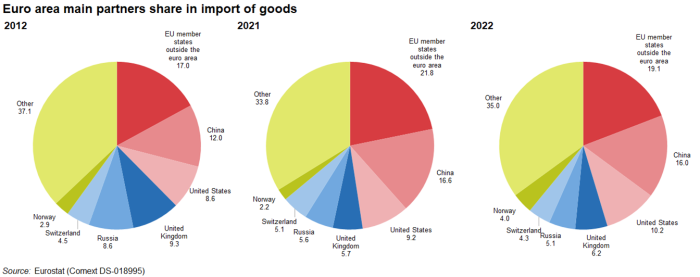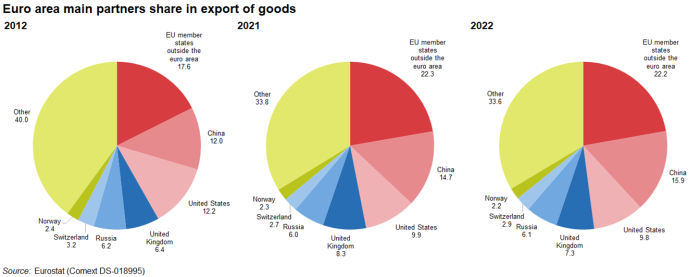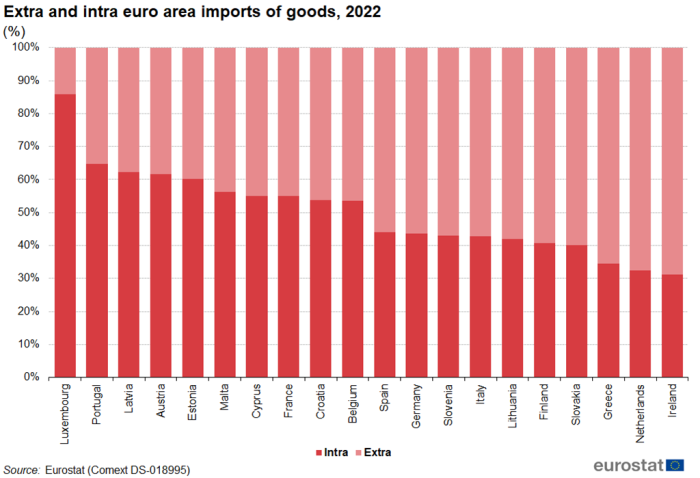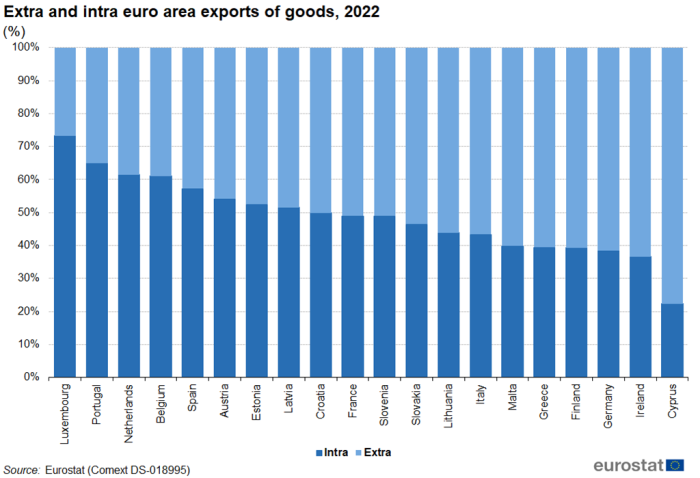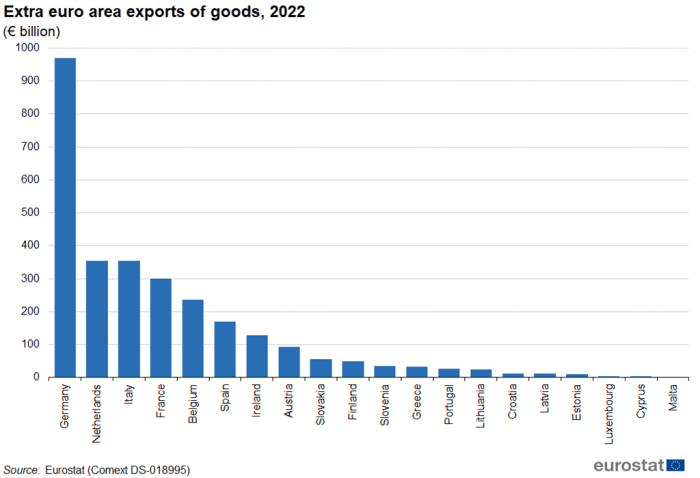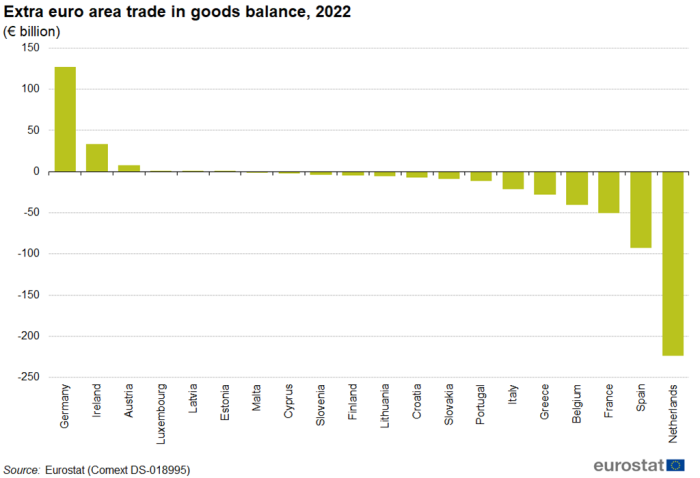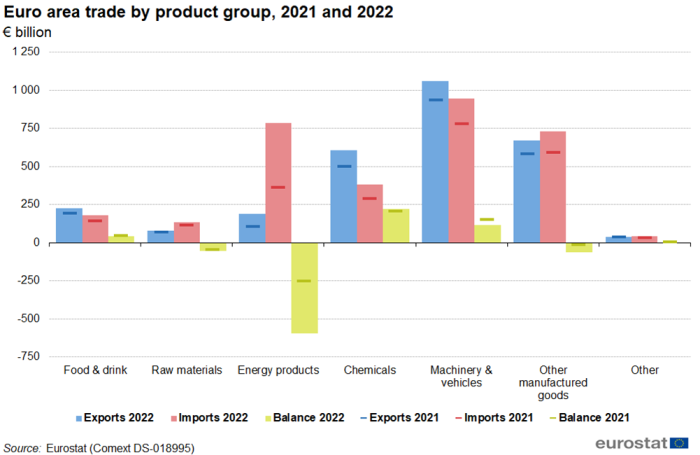Extra-euro area trade in goods
Data from March 2023.
Planned article update: 23 April 2024.
Highlights
In 2022, after several years of surpluses, the euro area recorded a trade deficit of €333 billion due to sharply increasing prices of energy.
Total euro area trade with non-EU member countries increased between 2012 and 2022 with an average annual growth of 5.1 % with imports (5.9 %) growing faster than exports (4.3 %).
The main products traded by the euro area in 2022 were machinery and vehicles.
Euro area trade, 2012-2022
The aim of this article is to provide an overview of the main characteristics of the extra-euro area trade in goods. All the series have been recalculated to include all the 20 members of the euro area in 2023.
This article is part of an online publication providing recent statistics on international trade in goods, covering information on the EU's main partners, main products traded, specific characteristics of trade as well as background information.
Full article
Increase in extra-euro area trade
Between 2012 and 2022 there was an increase in both extra-euro area imports of goods (from €1 801 billion to €3 202 billion) and exports of goods (from €1 876 billion to €2 868 billion) - see Figure 1. This development changed the trade in goods surplus of €75 billion in 2012 to a deficit of €333 billion in 2022.
In the period 2012-2022 euro area imports had an average annual growth of 5.9 % and exports grew by 4.3 % annually. Coming out of the COVID-19 slump, growth was already strong in 2021 with exports growing by 14.3 % and imports by 22.2 %. In 2022, driven by rising prices, growth was even higher, with exports growing by 18.0 % and imports by 37.7 %.
Main partners for extra-euro area trade
The share of euro area imports of goods to EU Member States outside the euro area increased by 2.1 percentage points (pp) between 2012 and 2022. In the same period China's share increased by 4.0 pp. Initially, between 2012 and 2021, the shares of the United Kingdom and Norway both dropped but between 2021 and 2022, their shares, as well as the share of the United States, increased due to an increase of energy imports from these countries partly replacing imports from Russia whose share fell by 0.5 pp between 2021 and 2022, despite increasing prices for energy products.
The share of euro area exports of goods to EU Member States outside the euro area increased by 4.6 pp between 2012 and 2022. In the same period China's share increased by 3.9 pp, while the share of the United States decreased by 2.4 pp.
Intra- and extra-euro area trade in goods by EU Member State
The share of intra-euro area imports varies greatly across members of the euro area. In 2022, it was above 60 % in Luxembourg, Portugal, Latvia, Austria and Estonia and below 40 % in Greece, Netherlands and Ireland. The high share of Luxembourg is explained by it being surrounded by euro area partners while Ireland's main trading partners are the United Kingdom and the United States.
In 2022, Luxembourg also had the highest share for intra-euro area exports of goods. Ireland had the second smallest share, only surpassed by Cyprus whose largest partner for exports was Hong Kong.
Extra-euro area trade in goods by EU Member State
In 2022, the four largest importers of goods in the euro area accounted for two-thirds of all extra-EU imports. Germany accounted for 26.3 % of imports, followed by the Netherlands (18.1 %), Italy (11.7 %) and France (10.9 %).
The same four countries were also the largest exporters, accounting for 69 % of extra-euro area exports. Germany accounted for 33.8 % of exports, followed by the Netherlands, Italy (both 12.3 %) and France (10.4 %).
Germany also had the largest trade surplus (€127 billion) with extra-euro area countries. It was one of six countries with a trade surplus. Thirteen countries had a trade deficit for extra-euro area trade which was highest in the Netherlands (€224 billion).
Machinery and vehicles dominate extra-euro area trade
By far the largest trade group for both extra euro area imports and exports was 'machinery and vehicles', with a trade value in 2022 of €2 007 billion. Of this, €1 061 billion were exports, representing 37 % of the value of all extra-euro area exports in 2022. Imports of 'machinery and vehicles' amounted to €946 billion which was 30 % of total euro area imports. Compared with 2021, exports of 'machinery and vehicles' were up €164 billion while imports were up €125 billion. Consequently, the trade surplus for 'machinery and vehicles' fell from €153 billion in 2021 to €114 billion in 2022 (Figure 6).
In 2022, the second largest product group for extra-euro area exports was 'other manufactured goods', for which total trade amounted to €1 402 billion. Of this, €671 billion were exports, representing 23 % of all extra-euro area exports.
Imports of 'other manufactured goods' stood at €731 billion in 2022 which was also 23 % of all extra-euro area imports. Compared with 2021, exports were up €88 billion and imports €138 billion. Consequently, the trade deficit for 'other manufactured goods' increased from €10 billion in 2021 to €61 billion in 2022.
In 2022, the second largest product group for extra-euro area imports was 'energy', for which total trade amounted to €973 billion. Of this, €190 billion were exports, representing 7 % of all extra-euro area exports.
Imports of 'energy' stood at €783 billion in 2022 which was 24 % of all extra-euro area imports. Compared with 2021, exports were up €81 billion and imports €422 billion. Consequently, the trade deficit for 'energy' increased from €253 billion in 2020 to €593 billion in 2022.
In 2022, the euro area also had a trade surplus in 'chemicals' (€220 billion) and 'food and drink' (€42 billion). It had trade deficits in 'other goods' (€2 billion) and 'raw materials' (€55 billion).
Source data for tables and graphs
Data sources
Euro area data come from Eurostat's COMEXT database. COMEXT is the Eurostat reference database for international trade. It provides access not only to both recent and historical data from the EU Member States but also to statistics of a significant number of non-EU member countries. International trade aggregated and detailed statistics disseminated from Eurostat website are compiled from COMEXT data according to a monthly process. Because COMEXT is updated on a daily basis, data published on the website may differ from data stored in COMEXT in case of recent revisions.
Euro area data are compiled according to community guidelines and may, therefore, differ from national data published by EU Member States. Statistics on extra-euro area trade are calculated as the sum of trade of each of the nineteen members with countries outside the euro area. In other words, the euro area is considered as a single trading entity and trade flows are measured into and out of the area, but not among euro are members.
Among the euro area partners in this article there are countries belonging to the EU in the years mentioned such as Czechia, Hungary, Poland, Sweden and the United Kingdom (until February 2020) and partners outside the EU (United States, China, Switzerland, Russia and Türkiye). The statistical concepts applicable to these two group of partners is different. Imports from non-EU trade partners are grouped by country of origin where imports from EU partners reflect the country of consignment. In practice this means that the goods imported from EU partners were physically transported from those countries, but part of these goods could have been of another origin. For this reason data on trade for these two groups are not fully comparable.
Unit of measure Trade values are expressed in billion (109) of euros. They correspond to the statistical value, i.e. to the amount which would be invoiced in case of sale or purchase at the national border of the reporting country. It is called a FOB value (free on board) for exports and a CIF value (cost, insurance, freight) for imports.
Context
The euro area is a large and open trading bloc. This makes doing business in euro an attractive proposition for other trading nations, which can access a large market using one currency. Euro area companies also benefit because they can export and import in the global economy while paying, and being paid, in euro, reducing the risk of losses caused by global currency fluctuations.
Direct access to

